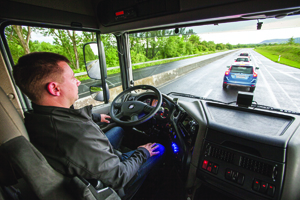Managing Editor, Features and Multimedia
Automation, Analytics to Shape Trucking’s Future

This story appears in the September 12 print edition of iTECH, a supplement to Transport Topics.
While many technologies will likely play a role in shaping the future of transportation, two of the most important will be the emergence of automated driving systems and the continuing evolution of data analytics.
Prime examples of those two trends were on display at a pair of technology demonstrations in recent months.
BEST OF SEPTEMBER iTECH: More stories, columns
The movement toward automated driving took the spotlight on a test track in Germany, where trucking and automotive supplier ZF Friedrichshafen showcased systems such as highway driving assist and evasive maneuver assist, which incorporated automated steering to help drivers and prevent accidents.
 Seth Clevenger
Seth ClevengerCloser to home, UPS Inc. provided Transport Topics with a demonstration of its ORION routing program in Timonium, Maryland, offering a clear example of how data analytics is shifting from merely collecting information to actively harnessing it to make business decisions.
While the last iTECH published in July explored the industry’s path toward autonomous trucks, this sector has seen several major developments just in the past two months.
Ride-sharing company Uber jumped into commercial vehicle automation by purchasing Otto, a startup firm working to develop aftermarket self-driving systems for trucks.
Meanwhile, ZF recently invested in lidar sensor technology and announced its bid for braking supplier Haldex to strengthen its automated driving capabilities.
And on Aug. 23, while this issue of iTECH was in production, technology firms Mobileye and Delphi Automotive announced a partnership to develop a fully automated driving system, which the companies intend to make ready for production in 2019.
Despite this growing focus on automation, challenges remain. In late June, it was revealed that a fatal accident involving a Tesla passenger car occurred while the vehicle’s so-called Autopilot system was engaged. While that crash remains under investigation, the incident grabbed headlines and illustrated some of the hurdles that could slow the advance of automated driving.
However, we should not lose sight of its potential to dramatically improve highway safety. Computers aren’t perfect, and they probably never will be, but they don’t become tired behind the wheel and they don’t drive while intoxicated or distracted by texting or playing Pokemon Go.
American Trucking Associations’ new president, Chris Spear, has been outspoken on the subject of autonomous trucks.
In an Aug. 16 appearance on Fox Business News, Spear stressed the importance of the Federal Communications Commission’s pending decision on dedicating wireless spectrum to connected vehicle technologies that could prevent crashes rather than sharing it with the cable industry. He also said he views autonomous trucks not as a potential job loss issue but as a development that could help attract more drivers to the industry and make them more productive.
Analytics also holds potential to yield gains in productivity and efficiency, as is the case with UPS and its ORION program.
At its core, the ORION routing program represents the application of advanced analytics.
UPS explained that the first step in analytics is describing what happened. The next are diagnosing why something happened, then predicting what will happen, and, finally, prescribing what to do based on that information.
Expect to hear much more about automation and advanced analytics in the years ahead. If you aren’t yet considering how you might apply these technologies in your business, it’s time to give it some thought.

